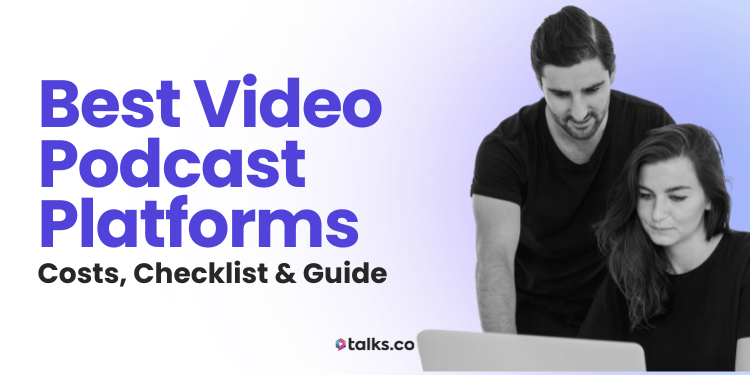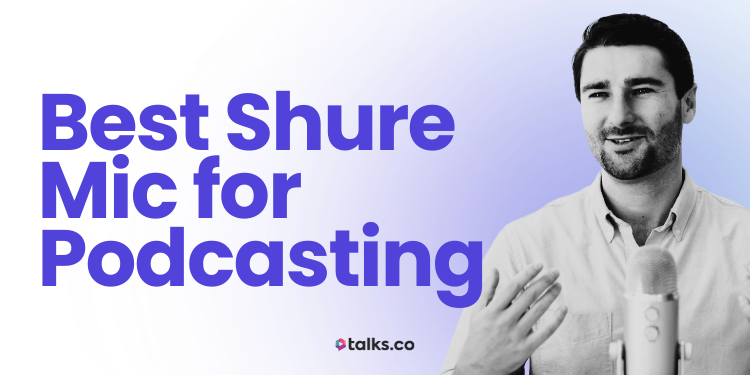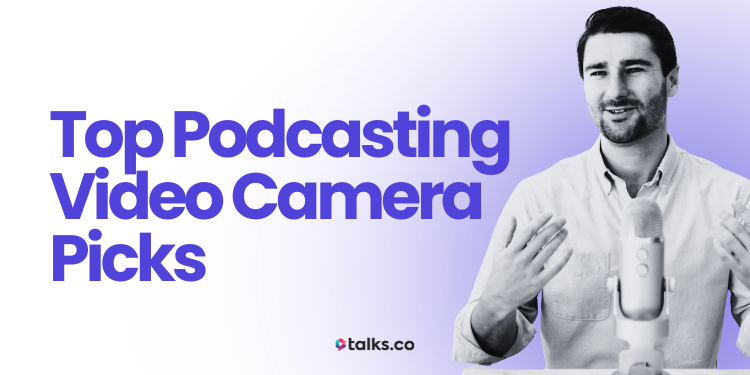Starting a video podcast is tougher than it looks. You’ve got the ideas, the topics, maybe even the guests lined up.
Then the questions hit: what’s the best platform you should use? How do you record it properly? Is your audio and video content even good enough? And have you been doing it wrong this whole time?
I’ve done over 400 interviews as host and guest, and I’ve seen it all. The messy setups, the tech issues, that one platform for video that just didn’t hit the mark.
Getting your podcasting platform, setup, and recording right can feel like a mountain when you don’t know where to start.
This guide is built for you.
You’ll discover the best video podcast platforms, the top video podcast features that matter, and the top video podcasting tools that actually make recording audio and video content easier.
Stop guessing. Start recording. And put out that podcast you can be proud of.
Top 15 Different Podcast Platforms (Snapshot)
Podcasts can be recorded, hosted, and distributed in all sorts of ways.
Here’s a snapshot of 15 podcast hosting platforms and their hosting capabilities, each suited to different podcast content creators and needs.
- Best for beginner podcasters: Zoom
- Best for high-quality audio: Zencastr
- Best all-in-one recording + editing: Descript
- Best for live streaming + recording: StreamYard
- Best for reliable remote recordings: SquadCast
- Best for studio-quality video without a studio: Riverside
- Best for simple hosting with growth tools: Castos
- Best for monetization and cross-promotion: RedCircle
- Best for hosting + marketing features built in: Captivate
- Best for maximum reach and discoverability: YouTube
- Best for controlled, ad-free video hosting: Vimeo
- Best for hosting with monetization options: Podbean
- Best for beginner-friendly, simple setup: Buzzsprout
- Best for experienced podcasters needing reliability: Libsyn
- Best for built-in Spotify distribution: Spotify for Creators
What Is a Video Podcast?

A video podcast is exactly what it sounds like. You record the host, guest, or both on camera while delivering your content.
It adds a level of connection you don’t get with audio alone. Viewers can see facial expressions, body language, and energy, which helps you:
- Build authority and trust
- Keep your audience engaged
- Make your message more memorable
Most video podcasts also distribute across multiple platforms and podcast directories as audio, so people can watch or listen however they want.
What Is a Podcast Platform?
Podcast platforms are the tools you use to host and distribute your podcast. It’s the home base for your episodes.
A dedicated podcast hosting service or platform handles the heavy lifting, including storing your files, creating RSS feeds, connecting to platforms like Apple Podcasts, Spotify, or YouTube, and sometimes offering monetization tools.
Choosing the right video platform helps you:
- Manage your podcast with less hassle
- Maintain quality audio and video
- Reach your audience efficiently
15 Best Video Podcast Platforms
There are loads of platforms out there claiming to be the best for video podcasts. Some focus on recording, others on hosting solutions, and a few try to do both.
Picking the wrong one wastes time, kills momentum, and makes your podcast look unprofessional.
This list breaks down the top 15 video podcasting platforms and what each hosting platform offers so you can see which fits your needs, skill level, and goals.
Video podcast recording platforms
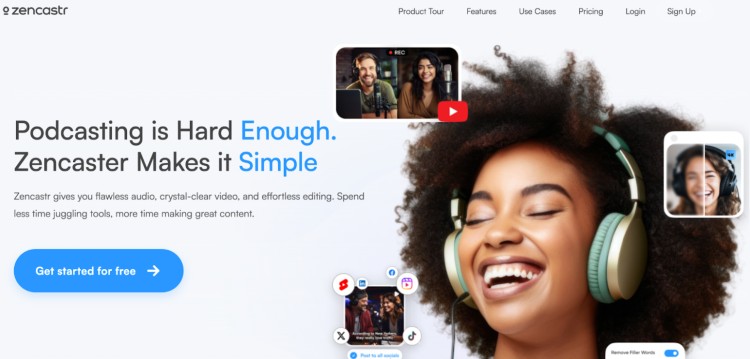
Recording is the first step, and selecting the best platform makes your podcast experience simple. These tools handle the tech so you get clear audio and video without any problems.
1. Zoom
Best for: Anyone who wants a simple, reliable way to record with multiple people
Zoom is that one popular software practically everyone knows. You can record both audio and video, bring in guests from anywhere, and save files locally or to the cloud.
It’s a free hosting option that’s simple, reliable, and I use it all the time when I don’t need fancy features like podcast analytics for my podcast episodes.
- Price: Free plan; Paid $13.33-$149/month
- Key features: Multi-person recording, local and cloud recording (paid), up to 30-hour meetings, 100-300+ participants
- Pros: Easy to use, works with almost anyone, widely known
- Cons: Quality depends on internet, free plan limited to 40-minute sessions
2. Zencastr
Best for: Podcasters who care about audio quality and want to include video podcast hosting
Zencastr offers hosting features that record each participant locally, so your audio comes out clean every time. Video’s included too, up to 1080p on the standard plan and 4K on higher tiers.
The ZenAI tools help remove filler words, handle post-production, and even create clips for social media.
- Price: 14-day free trial; Paid $20-$100/month
- Key features: Separate track recording, local recording, high-quality 16-bit 48k WAV audio, 1080p-4K video, transcription-based editing, ZenAI editing suite, social media clipping and publishing
- Pros: Studio-quality audio, separate tracks for easy editing, easy-to-use AI tools
- Cons: Video quality depends on plan, some advanced features require higher-tier subscription
3. Descript
Best for: Anyone who wants recording and editing in the same place
Descript is one of those all-in-one tools for audio and video. You can record, edit via text, handle screen recordings, and even use AI tools for filler word removal, transcription, or social media clips.
I like it when I want a single tool that does it all without jumping around software.
- Price: Free plan; Paid $24-$65/month
- Key features: Audio and video recording, transcription, text-based editing, screen recording, AI-powered post-production, export up to 4K, social media clip creation
- Pros: This podcast hosting platform offers fast editing, solid video features, AI tools that speed up post-production
- Cons: Can be heavy on your computer, free plan limited in features and export quality
Which platform is best for podcast shows with video?
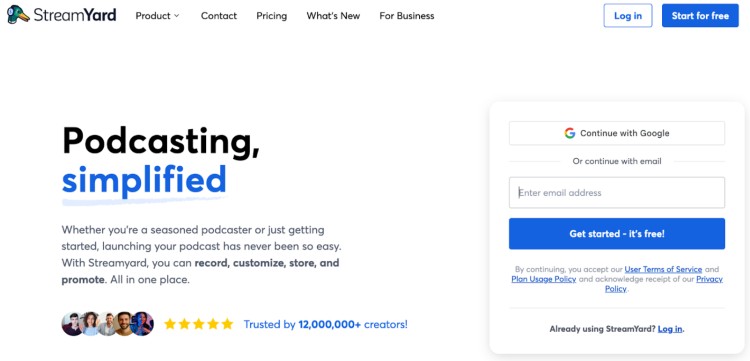
These are the heavy hitters for video-first podcasts.
These platforms allow you to experience high-quality video, easy recording, and branded podcast and video marketing tools to make your show look and sound professional.
4. StreamYard
Best for: Podcasters who want to record and stream live easily
StreamYard is built for live streaming but also doubles up nicely for recording podcasts. Everything runs in your browser, no downloads needed.
You can bring in multiple guests, add overlays, and push straight to YouTube, LinkedIn, or Facebook.
- Price: Free plan available; Paid $20-$49/month
- Key features: Live streaming, multi-guest support (6-15 on-screen participants depending on plan), full HD/4K video, brand overlays, pre-recorded streams, direct publishing to social platforms, cloud and local recordings
- Pros: Simple setup, streams directly to social media, good for panels and interviews
- Cons: Browser-based, so dependent on your internet connection
5. SquadCast
Best for: Podcasters who care most about reliable, high-quality recordings
SquadCast is all about clean remote recording. It’s known for its high-quality video and audio, automatically backing up files while you record.
It’s used by a lot of serious podcasters who don’t want to risk losing an episode.
- Price: Free plan available; Paid $24-$65/month
- Key features: Multi-track recording, video and screen recording, automatic cloud backups, AI tools for audio/video edits, integrations with Google, Apple, Outlook, export up to 4K, unlimited watermark-free exports depending on plan
- Pros: Reliable recordings, professional-level audio and video, easy guest access, cloud backup keeps your files safe
- Cons: No built-in live streaming, can feel pricey for beginners
6. Riverside
Best for: Podcasters who want studio-quality video without a studio
Riverside.fm is a heavyweight for video podcasting. It records each participant locally in 4K, then uploads while you’re still talking.
Big names use it because the final quality is studio-grade, even if your WiFi isn’t.
- Price: Free plan available; Paid $29-$99/month
- Key features: Local 4K recording, separate audio/video tracks, live streaming, audience call-ins, AI-driven editing, transcription, social clips, captions
- Pros: Excellent video and audio quality, reliable, strong post-production and live features to support video podcasts
- Cons: Learning curve for beginners, higher cost if you scale
Video podcast hosting platforms

These are the best podcast hosting platforms to store and manage your episodes. They handle your files, RSS feeds, and sometimes monetization so you can focus on creating content.
7. Castos
Best for: Podcasters who want a simple platform for video podcast hosting with built-in growth tools
Castos makes hosting straightforward and gives you extras like private podcasting and automatic republishing to YouTube. It’s clean, simple, and keeps the tech “must-knows” low.
- Price: Plans start at $19-$499/month
- Key features: Unlimited hosting, private podcasts, automatic YouTube republishing, detailed analytics, transcription, custom podcast webpage
- Pros: Simple to use, strong analytics, private podcast option
- Cons: Fewer integrations than larger platforms, design feels basic
8. RedCircle
Best for: Podcasters focused on monetization and cross-promotion
RedCircle is all about helping creators grow and make money. It offers features like dynamic ad insertion, listener donations, and tools for collaborating with other podcasters.
- Price: 7-day free trial; Paid $19.99-$119.99/month
- Key features: Ad marketplace, dynamic ad insertion, listener donations, cross-promotion, analytics, video generation for episodes
- Pros: Strong monetization options, easy cross-promotion, advanced analytics
- Cons: Smaller user base than some hosting provider competitors, advanced tools require paid plans
9. Captivate
Best for: Podcasters who want hosting + marketing built in
Captivate doesn’t just host your show; it’s built to help you grow it. From detailed analytics to built-in calls-to-action, it’s one of the best video podcast hosting platforms specifically designed for creators who want their podcast to pull its weight.
- Price: 30-day free trial; Paid $19-$99/month
- Key features: Unlimited podcasts, advanced analytics, built-in CTA links, dynamic content insertion, private podcasting, podcast website, marketing resources via Captivate Growth Labs
- Pros: Growth-focused features, unlimited shows, strong support
- Cons: Higher entry cost than some, interface can feel busy at first
Video podcast hosting sites

If you want your video podcast to be discoverable online, these are the best podcast hosting options that make it easy to upload and share your episodes with viewers across the web.
10. YouTube
Best for: Podcasters who want maximum reach and discoverability by adding video
YouTube is the best place to host video podcasts that get the most attention. It’s free to use and host your podcast, simple to upload, and doubles as a search engine for new podcast listeners.
- Price: Free podcast hosting service
- Key features: Global reach, video SEO, support video monetization through ads and memberships, live streaming
- Pros: Huge audience, strong discovery, built-in monetization for video creators
- Cons: Limited control over podcast distribution outside YouTube
11. Vimeo
Best for: Podcasters who want more control over their video hosting
Vimeo is built for creators who care about quality and control. You can host ad-free videos, customize your player, embed anywhere, and access monetization tools like subscriptions and pay-per-view.
- Price: 7-day free trial; Paid $20-$125/month
- Key features: Ad-free hosting, custom embeds, advanced analytics, live streaming, subscription monetization, pay-per-view, AI-powered translations, branding tools
- Pros: Clean, professional viewing experience, strong customization options, robust analytics, monetization tools, live streaming support
- Cons: Higher cost than some platforms, advanced features require higher-tier plans, smaller audience reach than YouTube
What are the major podcast platforms?
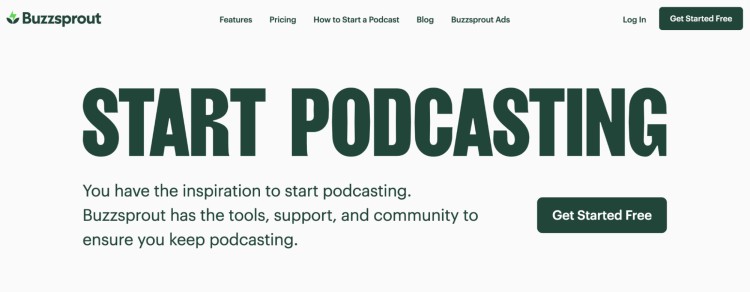
These major video podcasting platforms have the biggest reach.
These platforms are specifically designed to help you get your show in front of large audiences and make it easy to distribute across all platforms and podcast directories like Apple Podcasts and Spotify.
12. Podbean
Best for: Podcasters who want hosting with monetization options built in
Podbean offers free hosting while giving you ways to earn, like ads, premium subscriptions, and patron support. It’s a long-standing platform with plenty of flexibility.
- Price: Free basic plan; Paid $9-$79/month
- Key features: Unlimited hosting (paid plans), ad marketplace, premium podcasts, listener support, dynamic ad insertion, Apple Podcasts subscriptions, video podcast support
- Pros: Strong monetization options, easy to scale, reliable and established platform
- Cons: Free plan is limited, interface feels dated compared to newer platforms
13. Buzzsprout
Best for: Beginners who want a simple, user-friendly platform
Buzzsprout makes podcasting as easy as possible regardless of your current hosting experience.
Just upload your episode and it takes care of distribution to all major directories. Its clean interface makes it beginner-friendly.
- Price: Free basic plan; Paid $19-$79/month
- Key features: Automatic distribution, podcast website, listener support, subscriptions, Buzzsprout Ads, advanced stats, video soundbites, integration with podcast directories
- Pros: Simple to use, beginner-friendly, strong distribution network
- Cons: Limited upload hours on lower plans, fewer advanced features compared to pro platforms
14. Libsyn
Best for: Experienced podcasters who want control and reliability
Libsyn has been around since the early days of podcasting. It offers reliable hosting and detailed distribution options. It’s not the prettiest, but it’s built for serious podcasters.
- Price: Paid $7-$150/month
- Key features: Flexible hosting plans, advanced analytics, monetization tools, custom app options
- Pros: Reliable, affordable entry point, trusted by pros
- Cons: Outdated interface, not as beginner-friendly
15. Spotify for Creators
Best for: Podcasters who want built-in distribution and Spotify’s reach
Spotify for Creators lets you record, edit, and publish directly to Spotify. It’s free, simple, and gives you access to Spotify’s massive listener base.
- Price: Free
- Key features: Direct publishing to Spotify, in-app recording and editing, analytics, monetization tools
- Pros: Free to use, instant Spotify distribution, simple tools
- Cons: Limited editing features, distribution mainly tied to Spotify
What Equipment Do I Need for a Video Podcast? (Checklist)
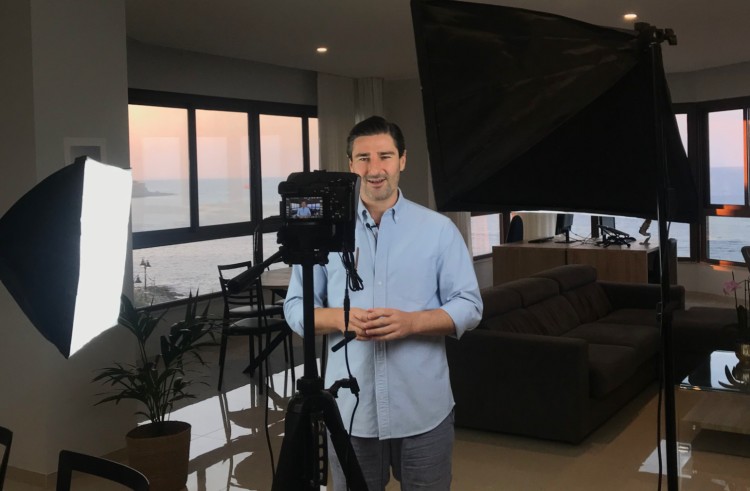
Before hitting record, you’ll need the right video podcast setup. Good gear makes the difference between a hobby-looking stream and a show people take seriously.
Here’s the essential checklist for all types of podcasts:
☐ Podcasting video camera: HD webcam or DSLR/mirrorless camera for crisp video.
☐ Microphone: USB mic (like Blue Yeti) or XLR with an audio interface for pro sound.
☐ Headphones: Closed-back, over-ear headphones to monitor audio without echo.
☐ Lighting: Softbox or ring lights for even, flattering lighting.
☐ Computer: A reliable laptop or desktop with enough power to handle video editing.
☐ Internet: Stable, high-speed connection (wired beats Wi-Fi).
☐ Recording software: A platform like Riverside, Zoom, or StreamYard to capture audio and video.
How do you start a video podcast?

Starting isn’t complicated, but it does take a few smart steps to make sure your show looks and sounds sharp:
- Pick your format: Solo, interviews, or panel-style.
- Set up your recording space: Quiet room, minimal echo, and good natural or artificial lighting.
- Run a tech check: Test your mic, camera, internet, and recording software before each session.
- Record your first episode: Keep it simple. Focus on clean sound and a clear topic.
- Edit and polish: Trim dead space, fix audio levels, and add intros/outros.
- Publish: Upload to your chosen platform and distribute via your podcast host.
Want more tips and ideas? Check out my full guide on how to start a video podcast.
8 Key features to look for in a video podcast platform
Not all audio and video podcasting platforms are created equal. Look for platforms with these must-haves that make adding video to your podcast and running your show easier:
☐ Local recording: Records on each person’s device for studio-quality results.
☐ Separate track recording: Keeps each speaker’s audio/video on its own track for easier editing.
☐ Cloud backup: Automatic file saves mean you won’t lose an episode if tech fails.
☐ High-resolution exports: Look for 1080p or 4K output so your video stays sharp.
☐ Built-in editing tools: Saves time with trimming, filler-word removal, or auto-clipping.
☐ Live streaming support: Lets you record and go live to YouTube, LinkedIn, or Facebook.
☐ Easy guest access: Simple, one-click invites so guests don’t struggle to join.
☐ Publishing options: Direct uploads to Spotify, YouTube, or your RSS feed streamline distribution.
7 Factors to consider when choosing a video podcast platform
Choosing the right video podcast hosting platform for you depends on your goals, budget, and workflow. Here are the key things to weigh up before committing:
- Ease of use: If you’re new, pick platforms like YouTube or Vimeo that are simple and intuitive.
- Recording quality: Look for the best platform for video podcast that supports HD/4K video and clear, lossless audio.
- Price: Match the subscription cost to your budget and the features you’ll actually use.
- Guest experience: Choosing the best platform that supports video podcasting includes making sure your guests can join without installing a bunch of software.
- Editing tools: Platforms that offer built-in tools can save you time, especially if you don’t want to juggle extra software just for high-quality video hosting features.
- Distribution options: Some platforms publish directly to Spotify, YouTube, or your RSS feed.
- Customer support: Reliable support for your podcast hosting platform is key and makes a big difference when you hit a snag mid-recording.
Podcast with Video Examples

Sometimes it’s easier to see video podcasting in action. Here are a few of my own appearances that show different ways to use video to grow your reach:
- Smart Podcast Guesting with Talks.co (AmplifYou Podcast Network): I share how to build a speaker profile that gets you booked without cold outreach, attract quality guests, and use AI tools to save time.
- How to Book More Podcast Appearances and Build Authority (The Social Media Takeaway): We cover creating a profile that stands out, finding the right shows, and when paid guest spots make sense.
- The Savvy Podcast | 7 Questions in 7 Minutes: A quick Q&A where I talk about launching summits, hosting 400+ speakers, and building programs that sell high-ticket offers.
Be Heard, Be Seen, Get Booked
Picking the right video podcast platforms sets the stage. It decides how easy your recording sessions run, how sharp your show looks, and how simple it is to publish.
The tech matters, but it’s only one part of the equation. The other side? Is reach.
A great-looking podcast doesn’t do much if the right people never see it. That’s why once your platform is locked in, the real play is getting in front of new listeners and lining up guests who bring their own audiences.
That’s where Talks comes in.
Create a free profile, showcase your show, and start connecting with guests who can put you in front of thousands of fresh ears.
